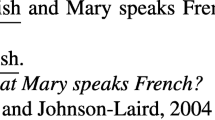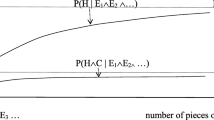Abstract
Crupi et al. (Think Reason 14:182–199, 2008) have recently advocated and partially worked out an account of the conjunction fallacy phenomenon based on the Bayesian notion of confirmation. In response, Schupbach (2009) presented a critical discussion as following from some novel experimental results. After providing a brief restatement and clarification of the meaning and scope of our original proposal, we will outline Schupbach’s results and discuss his interpretation thereof arguing that they do not actually undermine our point of view if properly construed. Finally, we will foster such a claim by means of some novel data.
Similar content being viewed by others
References
Atkinson D., Peijnenburg J., Kuipers T. (2009) How to confirm the disconfirmed: On conjunction fallacies and robust confirmation. Philosophy of Science 76: 1–21
Bovens L., Hartmann S. (2003) Bayesian epistemology. Oxford University Press, Oxford, UK
Crupi V., Tentori K., Gonzalez M. (2007) On Bayesian measures of evidential support: Theoretical and empirical issues. Philosophy of Science 74: 229–252
Crupi V., Fitelson B., Tentori K. (2008) Probability, confirmation and the conjunction fallacy. Thinking and Reasoning 14: 182–199
Earman J. (1992) Bayes or bust? MIT Press, Cambridge, MA
Festa R. (1999) Bayesian confirmation. In: Galavotti M., Pagnini A. (eds) Experience, reality, and scientific explanation. Kluwer, Dordrecht, pp 55–87
Fitelson B. (1999) The plurality of Bayesian measures of confirmation and the problem of measure sensitivity. Philosophy of Science 66: S362–S378
Fitelson B. (2006) Logical foundations of evidential support. Philosophy of Science 73: 500–512
Gigerenzer G. (1996) On narrow norms and vague heuristics: A rebuttal to Kahneman and Tversky. Psychological Review 103: 592–596
Hintikka J. (2004) A fallacious fallacy? Synthese 140: 25–35
Howson C., Urbach P. (2006) Scientific reasoning: The Bayesian approach. Open Court, Chicago/La Salle, IL
Kahneman D., Tversky A. (1996) On the reality of cognitive illusions. Psychological Review 103: 582–591
Lagnado D. A., Shanks D. R. (2002) Probability judgment in hierarchical learning: A conflict between predictiveness and coherence. Cognition 83: 81–112
Levi I. (1985) Illusions about uncertainty. British Journal for the Philosophy of Science 36: 331–340
Moro, R. (2008, forthcoming). On the nature of the conjunction fallacy. Synthese.
Osherson D. N., Smith E. E., Wilkie O., Lopez A., Shafir E. (1990) Category-based induction. Psychological Review 97: 185–200
Schupbach, J. N. (2009). Is the conjunction fallacy tied to probabilistic confirmation? Synthese. doi:10.1007/s11229-009-9698-2.
Sides A., Osherson D., Bonini N., Viale R. (2002) On the reality of the conjunction fallacy. Memory and Cognition 30: 191–198
Stich S (1990) The fragmentation of reason: Preface to a pragmatic theory of cognitive evaluation. MIT Press, Cambridge, MA
Tenenbaum J.B., Griffiths T.L. (2001) The rational basis of representativeness. In: Moore J.D., Stenning K. (eds) Proceedings of the 23rd annual conference of the Cognitive Science Society. Erlbaum, Hillsdale, pp 1036–1041
Tentori K., Bonini N., Osherson D. (2004) The conjunction fallacy: A misunderstanding about conjunction? Cognitive Science 28: 467–477
Tversky A., Kahneman D. (1982) Judgments of and by representativeness. In: Kahneman D., Slovic P., Tversky A. (eds) Judgment under uncertainty: Heuristics and biases. Cambridge University Press, Cambridge, UK, pp 84–98
Tversky A., Kahneman D. (1983) Extensional vs. intuitive reasoning: The conjunction fallacy in probability judgment. Psychological Review 90: 293–315
Author information
Authors and Affiliations
Corresponding author
Rights and permissions
About this article
Cite this article
Tentori, K., Crupi, V. How the conjunction fallacy is tied to probabilistic confirmation: Some remarks on Schupbach (2009). Synthese 184, 3–12 (2012). https://doi.org/10.1007/s11229-009-9701-y
Received:
Accepted:
Published:
Issue Date:
DOI: https://doi.org/10.1007/s11229-009-9701-y




